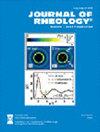三维打印杯形分形叶片中屈服应力流体的Rheo PIV
IF 3.2
2区 工程技术
Q2 MECHANICS
引用次数: 2
摘要
杯形叶片(VIC)几何形状已被广泛用于屈服应力流体的流变表征,因为它最大限度地减少了旋转几何形状的液/固界面处的滑移效应,并减少了加载过程中样品的损坏。然而,由于混合剪切流和拉伸流的空间复杂性,已经确定了复杂流体中定量流变测量的严重运动学限制。最近,具有分形横截面的叶片被建议作为弹粘塑性流体精确流变仪的替代品。在这项工作中,使用流变粒子图像测速仪(rheo PIV)分析了牛顿流体和非触变性Carbopol®940微凝胶的稳定分形杯内叶片(fVIC)流动以及触变性κ-卡拉胶凝胶的非稳定流动。我们描述了所有情况下的速度分布,并表明当与牛顿流体和微凝胶一起使用时,fVIC产生几乎轴对称的流场和与转速无关的“有效半径”。这些发现得到了2D模拟结果的支持,使Couette类比和扭矩-应力转换方案能够安全地用于24臂fVIC,并验证了它是一种用于表征各种复杂流体的可靠流变仪工具。然而,对于κ-卡拉胶凝胶,将流变仪工具插入样品时的轴向剪切/压缩也会加速脱水,最终导致Couette和fVIC流的剪切带。通过将使用24臂fVIC获得的结果与其他传统几何形状进行比较,我们研究了测量夹具的横向和横截面(剪切/压缩)面积对κ-卡拉胶凝胶在插入过程中破坏的影响。本文章由计算机程序翻译,如有差异,请以英文原文为准。
Rheo-PIV of yield-stress fluids in a 3D-printed fractal vane-in-cup geometry
The vane-in-cup (VIC) geometry has been widely used for the rheological characterization of yield-stress fluids because it minimizes slip effects at the liquid/solid interface of the rotating geometry and reduces sample damage during the loading process. However, severe kinematic limitations arising from the spatial complexity of mixed shear and extensional flow have been identified for quantitative rheometrical measurements in complex fluids. Recently, vanes with fractal cross sections have been suggested as alternatives for accurate rheometry of elastoviscoplastic fluids. In this work, the steady fractal vane-in-cup (fVIC) flow of a Newtonian fluid and a nonthixotropic Carbopol® 940 microgel as well as the unsteady flow of a thixotropic κ-Carrageenan gel are analyzed using rheo-particle image velocimetry (Rheo-PIV). We describe the velocity distributions in all cases and show that the fVIC produces an almost axisymmetric flow field and rotation rate-independent “effective radius” when used with both the Newtonian fluid and the microgel. These findings are supported by 2D simulation results and enable the safe use of both the Couette analogy and the torque-to-stress conversion scheme for a 24-arm fVIC as well as validate it as a reliable rheometrical tool for characterization of a variety of complex fluids. With the κ-Carrageenan gel, however, axial shearing/compression while inserting the rheometric tool into the sample also accelerates syneresis that ultimately results in shear banding for Couette and fVIC flows. By comparing results obtained using the 24-arm fVIC with other conventional geometries, we investigate the effect that the lateral and cross-sectional (shearing/compressing) area of the measuring fixture have on disrupting the κ-Carrageenan gel during its insertion.
求助全文
通过发布文献求助,成功后即可免费获取论文全文。
去求助
来源期刊

Journal of Rheology
物理-力学
CiteScore
6.60
自引率
12.10%
发文量
100
审稿时长
1 months
期刊介绍:
The Journal of Rheology, formerly the Transactions of The Society of Rheology, is published six times per year by The Society of Rheology, a member society of the American Institute of Physics, through AIP Publishing. It provides in-depth interdisciplinary coverage of theoretical and experimental issues drawn from industry and academia. The Journal of Rheology is published for professionals and students in chemistry, physics, engineering, material science, and mathematics.
 求助内容:
求助内容: 应助结果提醒方式:
应助结果提醒方式:


